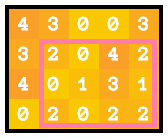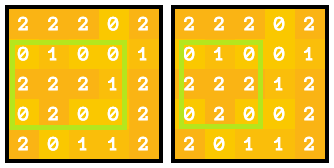Count the maximum number of ways to form a rectangle by replacing one digit in matrix?
anyone could give me some hint how to solve this problem?
..............................................................................................................................................................................................................
Hey, we're trying to form rectangles over a grid of numbers, where all four corners have the same number. The rectangles must have vertical and horizontal edges (no rotated rectangles). Here's an example:

In order to help maximize the total number of these rectangles that can be formed, we're allowed to change one number on the grid.
Given a matrix of integers, grid, return the indices of the element that we should change to yield the highest number of total rectangles. If there's a tie for the maximum number of rectangles, choose the answer with the smallest row index. If there's still a tie, choose the one with the smallest column index.
Example
For
grid = [[2,2,2,0,2], [0,1,0,0,1], [2,2,2,1,2], [0,2,0,0,2], [2,0,1,1,2]] the output should be rectangleReplacement(grid) = [4, 1].
There are 5 rectangles that can be formed by replacing the 0 at grid[4][1] with a 2:![]

It's also possible to form 5 new rectangles by replacing the 0 at grid[3][0] with a 2:
 but replacing that 0 would destroy 2 existing rectangles with a vertex at grid[3][0]:
but replacing that 0 would destroy 2 existing rectangles with a vertex at grid[3][0]:
 so effectively, this would only create 3 additional rectangles, which means that [4, 1] is a better choice.
so effectively, this would only create 3 additional rectangles, which means that [4, 1] is a better choice.
For
grid = [[2, 3],
[0, 7]]
the output should be rectangleReplacement(grid) = [0, 0]. In this case, we can't form any rectangles by replacing any single element, so why is the answer [0, 0]? Well to put it formally, the maximum number of total rectangles we can form is 0, and since any of the indices will produce this value, we'll choose the one with the lowest row index and the lowest column index (which is [0, 0]).
could anyone give me a general way to solve this task?
Easy Math Editor
This discussion board is a place to discuss our Daily Challenges and the math and science related to those challenges. Explanations are more than just a solution — they should explain the steps and thinking strategies that you used to obtain the solution. Comments should further the discussion of math and science.
When posting on Brilliant:
*italics*or_italics_**bold**or__bold__paragraph 1
paragraph 2
[example link](https://brilliant.org)> This is a quote# I indented these lines # 4 spaces, and now they show # up as a code block. print "hello world"\(...\)or\[...\]to ensure proper formatting.2 \times 32^{34}a_{i-1}\frac{2}{3}\sqrt{2}\sum_{i=1}^3\sin \theta\boxed{123}Comments
There are no comments in this discussion.